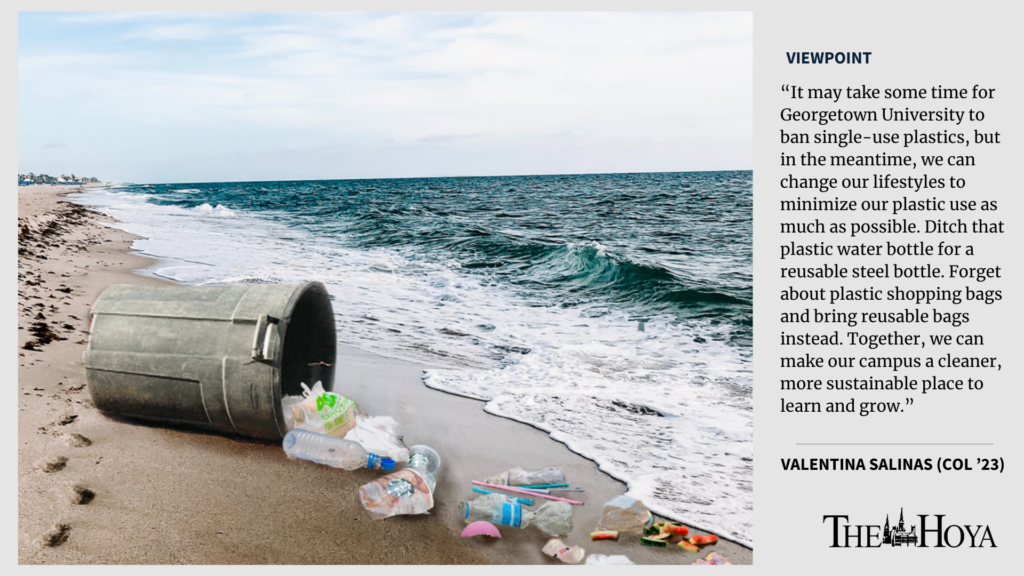The average American will throw away approximately 185 pounds of plastic every year, or about half a pound of plastic per day.
With multiple states predicted to run out of landfill space in upcoming years, the United States clearly has a trash problem. We produce an excessive amount of waste, and it is often mismanaged, finding its way to oceans, rivers, lakes, beaches, forests and other sensitive ecosystems. Not to mention that the incineration of our waste produces harmful chemicals that are released into the air, intensifying climate change and harming humans. But there is a way to reduce this destruction of our environment: banning unnecessary, trivial single-use plastic products and replacing them with compostable or eco-friendly alternatives.
Our problem started with Americans rapidly adopting single-use plastics as early as the eighties; currently, millions of people “enjoy” plastics for a few hours and then discard them. The world produces roughly 380 million tons of plastic per year, with as much as 50% being single-use plastic products. To put the issue into perspective, Americans dispose of enough plastic bottles in just one week to encircle the Earth four times. And plastic bottles are only a small piece of the puzzle.
Optimistically, we want to believe that recycling is the ultimate solution. Recycling can only temporarily solve our plastics problem, however. Most plastics are downcycled, meaning they are turned into lower-quality plastic products that will still eventually end up in landfills. Furthermore, some plastics are exported to other countries, resulting in environmental pollution and health risks to humans on a global scale.
Recycling cannot be the sole practice we depend on for reducing our waste and minimizing pollution. Only 8.7% of all plastics are recycled, making this method unhelpful by itself. Unsurprisingly, the other 91.3% travels to landfills, oceans, rivers and sensitive ecosystems, where it slowly breaks down into harmful microplastics.
The way to tackle our plastic waste problem is by reducing our rate of consumption for single-use plastics. Many places around the world and some U.S. states are working to ban single-use plastics and replace them with more sustainable options. California, for example, banned single-use plastic bags in 2014, and soon after the environmental organization Californians Against Waste observed a significant decrease of plastic bag contamination in the state’s beaches, freshwater and parks.
We should not permit something that we use for a few hours to pollute our oceans and landscapes for hundreds of years.
This semester, in collaboration with the Student Public Interest Research Groups, a student activist group that works with campuses across the country to make social change, a group of Georgetown University students are launching a Break Free From Plastic campaign with the ultimate goal of banning single-use plastics on campus.
The focus of our organization is on eliminating single-use plastics in dining locations across campus. We know there are recycling bins all over campus and that many Hoyas probably do recycle. However, our everyday abuse of single-use plastics causes harm in a multitude of ways, and frankly, we can do better.
So far, the Student PIRGs organization has had triumphs in places like California, where the University of California campuses have committed to eliminating single-use plastics by 2030. They will start with plastic bags in campus stores and dining halls and eventually replace utensils, plates, cups and single-use bottles with more sustainable and compostable alternatives.
As part of the younger generation, our obligation is to come together as a student body to contribute to protecting our planet and restoring the environment. That is why we are attempting to convince the university board to commit to banning single-use plastics on campus. Our organization’s goal is to make Georgetown a plastic-free environment in the upcoming years.
To accomplish such a lofty goal, we must start by raising awareness, especially with social media, about the single-use plastics issue as much as possible on campus. To fully eliminate plastics at Georgetown, we’ll need the help of the student body, professors and faculty, clubs and organizations, and even local business owners. Of course, this will be a lengthy process, but in the end, we hope to ask University President John J. DeGioia (CAS ’79, GRD ’95) to sign the Break Free From Plastic Campus Pledge — which all students can also sign — and transition Georgetown to a plastic-free and more sustainable campus.
It may take some time for Georgetown to ban single-use plastics, but in the meantime, we can change our lifestyles to minimize our plastic use as much as possible. Ditch that plastic water bottle for a reusable steel bottle. Forget about plastic shopping bags and bring reusable bags instead. Together, we can make our campus a cleaner, more sustainable place to learn and grow.
Valentina Salinas is a sophomore in the College.









